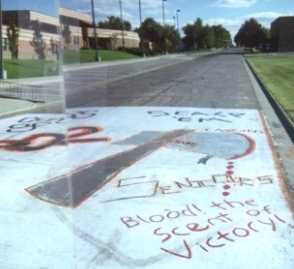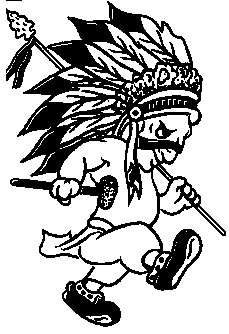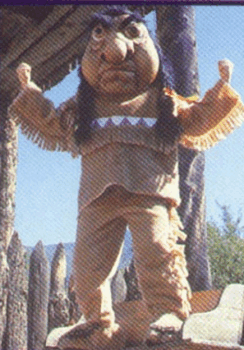 When I heard about the infamous Sports Illustrated poll, I fired off the following message to the pollsters:
When I heard about the infamous Sports Illustrated poll, I fired off the following message to the pollsters: When I heard about the infamous Sports Illustrated poll, I fired off the following message to the pollsters:
When I heard about the infamous Sports Illustrated poll, I fired off the following message to the pollsters:
I read this statement about the Peter Harris Research Group poll on Indian mascots conducted for Sports Illustrated:
"The pollsters interviewed 351 Native Americans (217 living on reservations and 134 living off) and 743 fans. Their responses were weighted according to U.S. Census figures for age, race and gender, and for distribution of Native American on and off reservations."
The statement raises a number of questions:
Because of these methodological problems, I don't think I've ever seen a survey purporting to present the Native American opinion on any subject. The problem of developing a truly random sample of an amorphous group is a huge one by itself. It's hard to believe Harris had more resources than the US government to accomplish this task. But if its sample wasn't random, the results are probably biased.
Until Sports Illustrated provides information on this poll's methodology, I'd say the Native community should take these results with a large grain of salt. They appear to confirm nothing more than the fact that Native opinion on the mascot issue isn't unanimous—which Native people already knew.
Rob Schmidt
The short version of this analysis is that there's no single definition of Indian and no single list of people identified as Indian. The poll is inherently flawed because an accurate sampling of an amorphous population is impossible.
Incidentally, neither Sports Illustrated nor Harris responded to this message. As far as I know, they never published their survey methodology.
In Of Polls and Race Prejudice: Sports Illustrated "Errant 'Indian Wars'," several Native experts provided a comprehensive overview of the poll's biased assumptions and methodology. I'm glad to say their conclusions agreed with mine.

Legitimate research ignored
From "'Scalp the Indians' from a American Indian Perspective" by Cara Cowen and B.J. Boyd. In the Daily O'Collegian, 9/27/05:
One source of continued frustration for us is public discourse on the issue continues to be relegated to the op-ed section of newspapers and the straw polls of sports magazines while a growing body of legitimate academic and scientific work on the topic is ignored.
This literature shows that Indian mascots promote misunderstanding and discrimination against Indian people and are harmful to the self-esteem of Indian youth.
Despite this body of work, the one piece of data that pro-mascot commentators often refer to is a 2002 poll sponsored by Sports Illustrated which suggests most American Indians are in favor of Indian sports mascots.
However, attempts to legitimate this study have been for naught as the conductors of the poll refuse to share the methodology and raw data with outside reviewers, removing from the arena of acceptable research.
The American Psychological Association has released a statement in opposition of Indian mascots, included is a reference list of pertinent literature of scholarly quality. It is available online at http://www.apa.org/pi/oema/resolution_american_indian_mascots.pdf.
In For Dignity's Sake, Stop Using Indians as Sports Mascots (Houston Chronicle, 9/17/05), Tim Giago discusses the Indians who support mascots:
When I appeared on a national call-in radio talk show on mascots I experienced some of the most pointed hatred I have ever experienced in my lifetime. I learned that some of the callers claiming Indian blood who were fully supportive of the use of Indians as mascots were generally from eastern tribes. When I in turn questioned them about their tribal affiliations I soon discovered that nearly all of them had been totally assimilated into the mainstream and spoke as non-Indians rather than as Indians with deep and lasting ties to their culture, traditions and spirituality. Most established eastern Indian tribes have also passed resolutions opposing the use of Indians as mascots.
This anecdote reinforces what I've been saying. Unless a survey uses an extremely expensive and time-consuming methodology, it will draw on a non-random sample of Natives. In particular, it will overrepresent urban, educated, assimilated Natives who have phones and Internet access and who think more like non-Natives. It will (vastly) underrepresent the less educated, rural, traditional Natives who don't have phones or Internet access. That includes many of the Natives in the western US and Alaska—the very people who most often suffer from Indian stereotypes.

Another flawed poll
Here's another poll with similar methodological flaws. From the Associated Press by way of Yahoo.com:
Poll: Skins' Nickname Offends Few Indians
Fri Sep 24, 8:40 PM ET
WASHINGTON -- A poll of American Indians found that an overwhelming majority of them are not bothered by the name of the Washington Redskins (news).
Only 9 percent of those polled said the name of the NFL team is "offensive," while 90 percent said it's acceptable, according to the University of Pennsylvania's National Annenberg Election Survey, released Friday.
Annenberg polled 768 Indians in every state except Hawaii and Alaska from Oct. 7, 2003, to Sept. 20, 2004.
The survey found little disparity between men and women or young and old. However, 13 percent of Indians with college degrees said the name is offensive, compared with 9 percent of those with some college and 6 percent of those with a high school education or less. Among self-identified liberals, 14 percent found the term disparaging, compared with 6 percent of conservatives.
The franchise began in Boston as the Braves but was purchased in 1932 by George Preston Marshall, who changed the name to honor head coach William "Lone Star" Dietz, an American Indian. The team kept its monicker after moving to the nation's capital in 1937.
The name and feather-wearing mascot have since been challenged.
A panel of the U.S. Patent and Trademark Office canceled the team's trademarks in 1999 on the grounds that the name disparages American Indians in violation of federal trademark law. But last year, a federal judge ruled the team can keep its name, finding insufficient evidence to conclude it is an insult to American Indians.
Some Indian leaders are still pressing their case, noting that many schools with similar mascots referencing Indians have made name changes in recent years.

Rob's comment
This poll undoubtedly has the same methodological flaws as the Sports Illustrated poll. Among the potential flaws:
Related links
Team names and mascots: The hard numbers
Red·skin n. Dated, offensive, taboo
Smashing people: the "honor" of being an athlete
|
. . . |

|
All material © copyright its original owners, except where noted.
Original text and pictures © copyright 2007 by Robert Schmidt.
Copyrighted material is posted under the Fair Use provision of the Copyright Act,
which allows copying for nonprofit educational uses including criticism and commentary.
Comments sent to the publisher become the property of Blue Corn Comics
and may be used in other postings without permission.